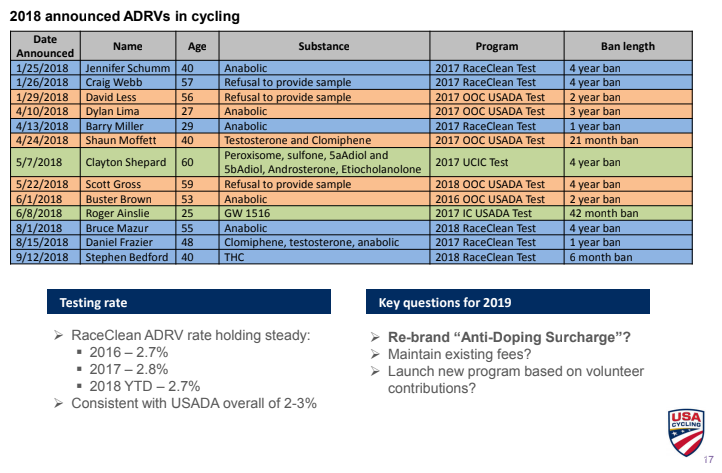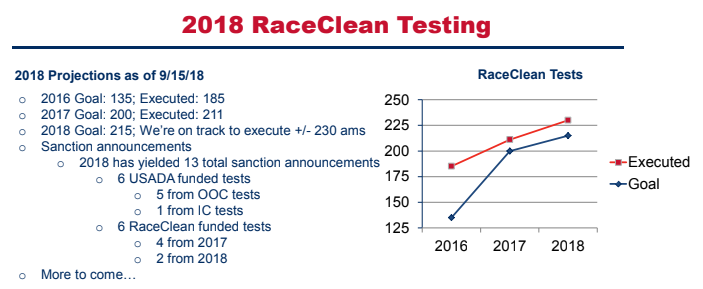State of the Sport: Racing in 2018
We’ve written about the ‘State of the Sport’ before - be it the increasingly challenging economics of race promotion, our suggestion to end amateur prize money in cycling, a detailed review of the (not so good) demographics of cycling, and of course New York City’s crisis level shortage of USAC officials (which led to race cancellations in this most recent season). Now with winter settling in we’re preparing to fight off cabin fever by diving back into the topic through some of our experiences from 2018 and what we think they may mean for bike racing in the USA.
Though before we jump into that more complex topic, we figured that we would start with something easy: a review of where USA Cycling and USAC Racing stand. You may have seen that USAC CEO Derek Bouchard-Hall is officially stepping down from USA Cycling after four years at the helm to join ASSOS (see part 1 and part 2 of his Velonews exit interview). Where does he leave the sport? To find out lets dig into some of the data provided at the recent Local Association Summit just over one month ago.
USAC Membership & Participation
There is some good news when it comes to participation: after several years of post-Lance declines USAC membership actually increased this year compared to 2017. Unfortunately the top right chart underscores that the context isn’t entirely rosy. Race days per membership reached a new low in 2018, down more than 20% from the 10+ race days experienced from 2007 until 2013. What does this mean? It means that total USAC race participant days (e.g. the total race days for all USAC members) continued its downward trajectory.
And with fewer race days there is less registration revenue available to race promoters, which against the backdrop of the fixed cost structure and broad cost inflation we discussed in ‘Are Bike Races Broken?’ makes life even tougher for event organizers. The chart on the bottom right - showing record low race events - is probably no surprise in this context. So when it comes to participation: license numbers have stabilized but race days and the number of available events are all touching new lows this year.
New York City Participation
Does this line up with local NYC experience? Zeroing in on CRCA the answer is not really. CRCA membership was down ~3% in 2018, creating tension with the club’s minimum marshaling requirements as the club’s race calendar has expanded and the required marshals per race have generally increased. This definitely inspires some anxiety with 2019 planning but on the bright side race participation has remained very strong. In fact, while we caution against reading too much into such a small sample size, especially with the role friendly weather and state championships played this year, for the core CRCA Open Race calendar participation was up slightly this year and just a touch below the 2016 peak (these figures exclude the Lou Maltese Memorial which was run as a Club Race in 2018):
Looking at it on a race by race basis, the Grant’s Tomb Criterium has been the primary driver, growing each of the past three years and approaching nearly 800 registrants for the most recent, State Championship infused, edition (crazy great turnout). Bear Mountain was the next most popular race this year, again benefiting from State Championship status that is particularly important given the huge cost base for that race (see ‘Are Bike Races Broken?’ for additional detail) and lackluster 2017 registration that left us wondering whether the race was still viable -hopefully 2017 is an outlier and we don’t reverse to those levels as the State Championships move elsewhere in 2019. Orchard Beach has been cursed by mediocre weather in recent years and has been on a three year downward trend while the Dave Jordan Central Park Classic and Mengoni Grand Prix remain ‘steady as they go’ (DJCPC trends would be up if adjusted for the unfortunate elimination of youth/junior fields per the terms of our Parks permits).
So locally CRCA membership was down, sparking concerns for marshal availability, but Open Race participation seems to be holding in well - helped by the fact that metro New York City hasn’t lost any significant races recently and if anything might have gained total race days with the new FBF series that took place this year (though the shortage of USAC officials is reaching critical levels and has very real potential to result in 2019 race cancellations).
USAC Membership By Region
Zooming out slightly and looking at USAC’s regional data provides some additional backdrop for why CRCA Open Race participation is holding up - New York remains one of the core drivers of USAC’s 2018 membership growth with an 8% increase in total 2018 membership even NYSBRA remains one of the largest Local Associations operating under the USAC umbrella (good growth in a big LA is a good sign):
It is also interesting to note that almost all local associations experienced slight membership growth with a few large regions - SoCal and Arizona in particular - seeing slight declines. It would be interesting to know why those large race populations are shrinking while USAC as a whole managed to grow in 2018 (Florida, another big LA, was essentially flat as well).
USAC Racer Days by Permit Type
Shifting back again to the national numbers its probably no surprise that Gran Fondo racer days are the fastest growing format at USAC, albeit off a small base. Meanwhile traditional competitive race days were down sharply as of when this data was pulled in September. Obviously this is national level data but as a race promoter seeing high single digit declines in participation is anxiety inducing when it comes to maintaining reasonable economics.
What Does It All Mean?
If your conclusion is that the data is a mixed bag - we agree with you. Stabilizing membership numbers is a big success that should be celebrated (though as friend of the team Taylor Kuyk-White pointed out, perhaps this is a function of the auto-renewals that were introduced for 2018 membership?). But the racer day numbers suggest the outlook for USAC events continues to get more challenging. And the pessimistic read would be that as event economics get more challenging, more races will fold, and as those races fold it gets increasingly difficult to maintain membership levels given fewer race opportunities and less justification for buying a USAC license, which causes still more races to fold… …creating a downward spiral for the sport (or at a minimum a shift toward the triathlon/gran fondo model with fewer, more expensive races on each member’s calendar).
Of course, as the CRCA numbers underscore, its definitely not all bad news - registration trends are holding in pretty well in New York City and the NYSBRA LA is reporting healthy growth in membership. But we’ll save the next layer of discussion for our next post where we’ll dig into more of the numbers and some of our our personal experiences during the past year.
For now we’ll leave you with a few quick data points on everyone’s favorite subject, Anti-Doping where positive tests continue to run in the 2-3% of total tests context:

